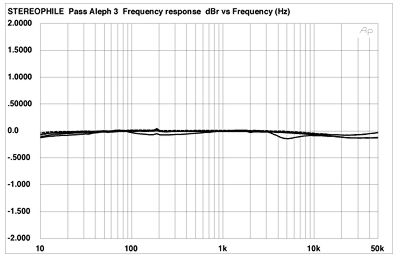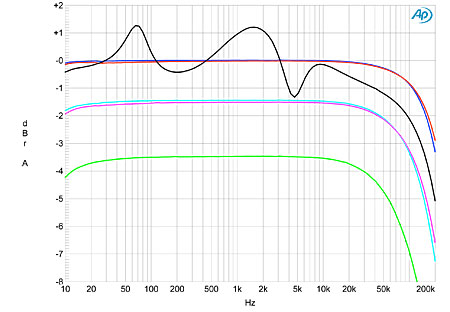Solid-state: Pass Aleph 3
Tube: BAT VK-55SE
Not sure what the question was that led to your answer Gary

but here is some measurements:
Pass Aleph 3:
Fig.1 shows the Aleph 3's frequency response. It is nearly ideal—even with our simulated real load, the deviation from flat is inconsequential.
And BAT:
Fig.1 Balanced Audio Technology VK-55SE, High output tap, frequency response at 2.83V into: simulated loudspeaker load (gray), 8 ohms (left channel blue, right red), 4 ohms (left cyan, right magenta), 2 ohms (green). (1dB/vertical div.)
So what do we learn here?
Someone should be fired at stereophile magazine

. Why? Why on earth would they use different scales to show the same graph? One goes to 50 KHz, another to 200 KHz. The first graph only has the simulated load but the second has two other. Why not have the same measurements for both so that we can properly compare?
So let's take the simulated load as that is the common thread. The BAT surely has wild variations in the response.
Now let's read some of the subjective words from the review:
"....the VK-55SE was a tad more tonally rich delivering the chorus than the Atlas or Nu-Vista, and the Atlas had a bit more sparkle than the Nu-Vista and the '55SE. ..."
"...the sound was vivid, relaxed, and liquid. Delmoni's 1780 J.B. Guadagnini violin has an unusually big sound, and the '55SE reproduced that bigitude, and the Guadagnini's timbral impact, with clarity—it didn't sound too big or too bright, but just right...."
Let me ask you this: which one of these two evaluations is more reliable? If I measured the unit again, would it produce wildly different results?
What if I had someone else review the BAT? Would they use the same words or even similar ones? What if I took the markings off the BAT and put in the box with the name Mark Levinson on it making it look like a solid state amp? Would the above words change in the review then? What if it said Carver or Sony on it? What if I said it cost $500 for the amp or $50,000? Would the words change?
Above all, how are the above words any different than any other high-end amp review? And what do the words really mean anyway? Sparkle means what? More highs? What does "ease" mean?
So again, without judging the execution, how would you rate the
reliability of each evaluation type?







